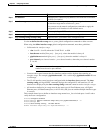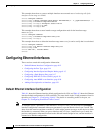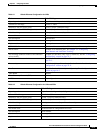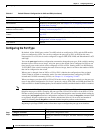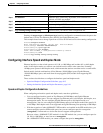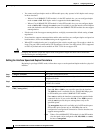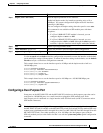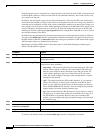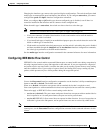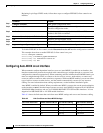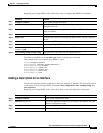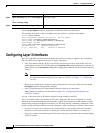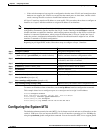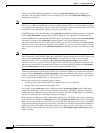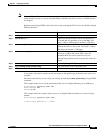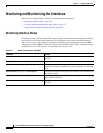
9-19
Cisco ME 3400 Ethernet Access Switch Software Configuration Guide
OL-9639-06
Chapter 9 Configuring Interfaces
Configuring Ethernet Interfaces
Changing the interface type, removes the speed and duplex configurations. The switch configures both
media types to autonegotiate speed and duplex (the default). If you configure auto-select, you cannot
configure the speed and duplex interface configuration commands.
When you configure sfp or rj45 media type, the non-configured type is disabled, even if there is a
connector installed in that interface and no connector in the configured one.
When the media type is auto-select, the switch uses these criteria to select the type:
Note An SFP is not installed until it has a fiber-optic or copper cable plugged in.
• If only one connector is installed, that interface is active and remains active until the media is
removed or the switch is reloaded.
• If you install both types of media in an enabled dual-purpose port, the switch selects the active link
based on which type is installed first.
• If both media are installed in the dual-purpose port, and the switch is reloaded or the port is disabled
and then reenabled through the shutdown and the no shutdown interface configuration commands,
the switch gives preference to the SFP module interface.
See the media-type interface configuration command in the command reference for more information.
Configuring IEEE 802.3x Flow Control
IEEE 802.3x flow control enables connected Ethernet ports to control traffic rates during congestion by
allowing congested nodes to pause link operation at the other end. If one port experiences congestion
and cannot receive any more traffic, it notifies the other port by sending a pause frame to stop sending
until the condition clears. Upon receipt of a pause frame, the sending device stops sending any data
packets, which prevents any loss of data packets during the congestion period.
Note Ports can receive, but not send, pause frames.
You use the flowcontrol interface configuration command to set the interface’s ability to receive pause
frames to on, off, or desired. The default state is off.
When set to desired, an interface can operate with an attached device that is required to send
flow-control packets or with an attached device that is not required to but can send flow-control packets.
These rules apply to IEEE 802.3x flow control settings on the device:
• receive on (or desired): The port cannot send pause frames but can operate with an attached device
that is required to or can send pause frames; the port can receive pause frames.
• receive off: IEEE 802.3x flow control does not operate in either direction. In case of congestion, no
indication is given to the link partner, and no pause frames are sent or received by either device.
Note For details on the command settings and the resulting IEEE 802.3x flow control resolution on local and
remote ports, see the flowcontrol interface configuration command in the command reference for this
release.



